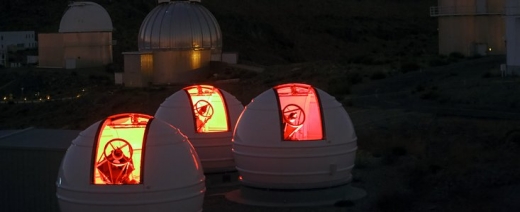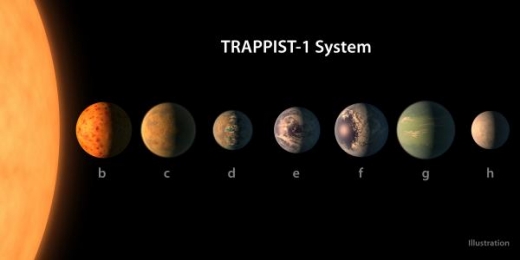A new project called Exoplanets in Transits and their Atmospheres (ExTrA) has been set in motion at the European Southern Observatory’s site at La Silla (Chile). Funded by the European Research Council and the French Agence National de la Recherche, ExTrA’s three 0.6-metre telescopes will be operated remotely from Grenoble, France. This is an exoplanet transit effort centered around finding and characterizing Earth-sized planets orbiting M-dwarf stars.
Not an easy task from the ground, as lead researcher Xavier Bonfils makes clear, though if you’re going to attempt it, northern Chile offers optimum conditions:
“La Silla was selected as the home of the telescopes because of the site’s excellent atmospheric conditions. The kind of light we are observing — near-infrared — is very easily absorbed by Earth’s atmosphere, so we required the driest and darkest conditions possible. La Silla is a perfect match to our specifications.”
To do its work, ExTrA weds spectroscopic information to traditional photometry. The collected light from the target star is fed through optical fibres into a multi-object spectrograph. Known as differential photometry, the method involves collecting light not only from the target but also from four comparison stars. The comparison helps the technology filter out atmospheric distortions and effects produced by the instruments and detectors themselves.

Image: A new national facility at ESO’s La Silla Observatory has successfully made its first observations. The ExTrA telescopes will search for and study Earth-sized planets orbiting nearby red dwarf stars. ExTrA’s novel design allows for much improved sensitivity compared to previous searches. Astronomers now have a powerful new tool to help in the search for potentially habitable worlds. Credit: ESO.
Bonfils adds:
“With the next generation of telescopes, such as ESO’s Extremely Large Telescope, we may be able to study the atmospheres of exoplanets found by ExTra to try to assess the viability of these worlds to support life as we know it. The study of exoplanets is bringing what was once science fiction into the world of science fact.”
Thus ground-based observation continues to increase in precision, soon to be supplemented by space missions like the Transiting Exoplanet Survey Satellite (TESS), the James Webb Space Telescope (JWST) and the European CHaracterising ExOPlanet Satellite (CHEOPS).
Close Look at TRAPPIST-1
And while we’re talking about M-dwarfs, a new paper is out looking at one of the most interesting systems yet discovered, comprising the seven planets around TRAPPIST-1. Lead author Amy Barr (Planetary Science Institute) and colleagues go to work on the interior structures of these planets as well as their tidal heating and convection given what we know about their mass and radius. The balance between tidal heating and convective transport has implications for the mantles of each planet.

Image: A size comparison of the planets of the TRAPPIST-1 system, lined up in order of increasing distance from their host star. The planetary surfaces are portrayed with an artist’s impression of their potential surface features, including water, ice, and atmospheres. The paper from Amy Barr, Vera Dobos and László L. Kiss shows that planets d and e are the most likely to be habitable due to their moderate surface temperatures, modest amounts of tidal heating, and because their heat fluxes are low enough to avoid entering a runaway greenhouse state. Planet d is likely covered by a global water ocean. Credit: NASA/R. Hurt/T. Pyle.
Given that their orbits are slightly eccentric, there is the possibility of tidal heating, which in the Galilean moons has intrigued us for its possibilities at providing an energy source for life beneath an icy crust, and indeed, the paper notes that “…on planets b, e, f, g and h, life might appear in the tidally heated (subsurface) ocean close to hydrothermal vents.“
In the TRAPPIST-1 system, though, we have much to learn about the composition of the respective worlds. The Barr paper examines the limits of present knowledge:
Assuming the planets are composed of water ice, rock, and iron, we determine how much of each might be present, and how thick the different layers would be. Because the masses and radii of the planets are not very well-constrained, we show the full range of possible interior structures and interior compositions.
The paper is a thoroughgoing examination of the TRAPPIST-1 planets, with planets d and e flagged as the most likely to produce habitable conditions. Here tidal heating would be modest and heat flux low enough to avoid runaway greenhouse conditions:
Planet d is likely to be covered by a global water ocean, and can be habitable if its albedo is ? 0.3. Planetary albedos may be estimated from photometric measurements during occultations (see e.g. Rowe et al., 2008) which may give an additional constraint on the habitability of TRAPPIST-1d. As discussed in Section 5, planet e is likely to have liquid water on its surface, too, according to climate models (Turbet et al., 2017; Wolf, 2017).
Planets f, g, and h, the authors believe, are rich in H2O, possibly containing liquid water oceans beneath a thick ice mantle. Planets b and c likely harbor magma oceans in their interiors. Planet b in particular demands further work, given its proximity to the central star and its “seemingly water-rich composition,” while c may experience eruptions from its magma ocean, a phenomenon that may eventually become detectable.
But note how far we have to go:
Our knowledge of the compositions of the four interior planets, chiefly, their water content, can significantly be improved if their masses can be determined to within ? 0.1 to 0.5M?, which will require further observations of the TRAPPIST-1 system.
The paper is Barr et al., “Interior Structures and Tidal Heating in the TRAPPIST-1 Planets,” accepted at Astronomy & Astrophysics (preprint).



Does this paper completely ignore the fact that these planets probably always have the same side toward their sun ? How can tidal lock not be relevant when you talk about tidal heating ? Is there any planet or moon with an atmosphere in our own system who even remotely resembles these conditions ?
I think you’ve got to put this one in your Earth Project list.
Don’t forget to add LUVOIR and HabEX to the space project list.
LUVOIR and HabEx already added. ExTrA will go up as soon as I see a stable home site for it.
Truly fascinating article, especial the densities and tidal heating. This is an example of how the the tides will change until there is better data, like the maps of old that portrayed strange things at the end of the world. The 3 twenyfour inch ExTrA telescopes that the French have installed, are they the follow on telescopes to the TRAPPIST telescope or are these another M dwarf telescope project?
Finally found the follow on to the Trappist telescopes:
SPECULOOS (Search for Planets EClipsing ULtra-cOOl Stars) project.
http://www.speculoos.uliege.be/cms/c_3272698/en/speculoos-portail
http://www.mpia.de/homes/ppvi/posters/2K066.pdf
Four one meter telescopes at the European Southern Observatory of Paranal, Chile. They should all be seeing first light soon!
TRAPPIST-1 & SPECULOOS planets
http://geco.oeaw.ac.at/resources/cheops/talks/Gillon.pdf
SAINT-EX
Another 1 meter scope in Mexico, the facility’s first light is foreseen in Spring 2018.
http://www.saintex.unibe.ch/
SPECULOOS Northern observatory in Morocco is still in the works with MIT supporting.
About the TRAPPIST-1 system: What about the flare star? Wouldn’t radiation from it still make those middle planets unlivable?
On one hand, of course red dwarfs are not the ideal home for life-bearing planets, as far as we know. But observing exoplanetary systems is an important scientific endeavor, whether we are hoping for alien life or not, and we are getting better and better at it. Kudos!
They might be ideal for visitors from other star systems who also happen to be artificial.
A New Atmospheric Disequilibrium Could Help Detect Life on Other Planets
Press Release – Source: University of Washington
Posted January 24, 2018 at 6:07 PM
http://astrobiology.com/2018/01/a-new-atmospheric-disequilibrium-could-help-detect-life-on-other-planets.html
Technosignatures?
Search for Extraterrestrial Intelligence’ Needs a New Name, SETI Pioneer Says.
“Astrophysicist Jill Tarter is one of the world’s best-known leaders in the search for extraterrestrial intelligence, or SETI. For 35 years, she served as the director of the Center for SETI Research (part of the SETI institute) and was also the project scientist for NASA’s SETI program, before its cancellation in 1993”.
https://www.space.com/39474-search-for-extraterrestrial-intelligence-needs-new-name.html?utm_source=feedburner&utm_medium=feed&utm_campaign=Feed%3A+spaceheadlines+%28SPACE.com+Headline+Feed%29
“Signs of Alien Technology” –Worlds’ SETI Search Shifts to Technosignatures.
http://www.dailygalaxy.com/my_weblog/2018/01/worlds-seti-search-shifts-to-technosignatures-signs-of-alien-technology-watch-todays-galaxy-stream.html?utm_source=feedburner&utm_medium=feed&utm_campaign=Feed%3A+TheDailyGalaxyNewsFromPlanetEarthBeyond+%28The+Daily+Galaxy+–Great+Discoveries+Channel%3A+Sci%2C+Space%2C+Tech.%29
“Science-fiction writer Arthur C. Clarke wrote that “any sufficiently advanced technology is indistinguishable from magic,” which would mean that alien technology could be as mysterious and unexplainable to humans as technologies that appear in science-fiction TV shows and movies. That opens up a dauntingly large range of possibilities for what technosignatures might look like. What if an alien civilization were communicating via a mechanism that Earth-based scientists haven’t discovered yet? Would humans immediately recognize these “magical” technosignatures, or would we not see them as unnatural? ”
Tarter said she prefers to focus on a slight alteration of Clarke’s prediction written by the futurist Karl Schroeder: “Any sufficiently advanced technology is indistinguishable from nature.”
Synchronicity & the Hidden Meaning of Coincidences.
Ser·en·dip·i·ty (s?r??n-d?p??-t?)
n. pl. ser·en·dip·i·ties
1. The faculty of making fortunate discoveries by accident.
2. The fact or occurrence of such discoveries.
3. An instance of making such a discovery.
I have been running into this recently, especially relating to Kepler’s Supernova’ and the constellation Ophiuchus. A concept that has not been expressed well in Seti that may have more merit is the possibility that we need to look at history and the development of megalithic structures. The amount of man hours that it has taken to build these structures and there many astronomical relationships – that have would be a good project with low coast. After all the exterrestrials have been around for a lot longer than the age of our solar system, so making contact might have had a completely different aspect then we normally assume. Archeoastronomy has a very rich history and and alot of data is available, what about using AI to connect the dots!~
Paul Gilster: Please read the PDF of ArXiv 1802.00141(ON the bio-habitability of M-dwarf planets.” by A Wandel. This is WAY OVER MY HEAD(I hope it is not over YOUR head, too), but I am EXTREMELY EXCITED that the author claims that SIX OF THE SEVEN TRAPPIST-1 planets MAY be habitable!!!! If possible, I would really like him to do a guest-post on this website to TRY to explain his findings in LAYMAN TERMS!!!!
UPDATED densities of the TRAPPIST-1 planets(accuracy within 5-12% for planets b-g)COMPARED to the density of the Earth: b-0.726 plus 0.092, minus 0.091; c-0.883 plus 0.083, minus 0.078; d-0.616 plus 0.067, minus 0.062; e-1.034 plus 0.076, minus 0.070; f-0.886 plus 0.038, minus 0.036(THIS is the 5% accuracy one); g-0.759 plus 0.034, minus 0.033(this is also CLOSE to 5% accuracy).
OOPS: The density with respect to the Earth of TRAPPIST-1 f is 0.816, NOT 0.886.